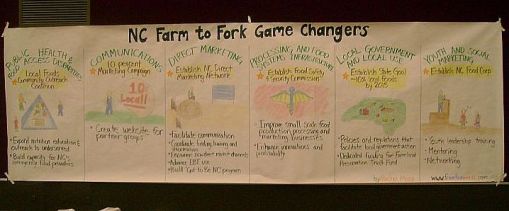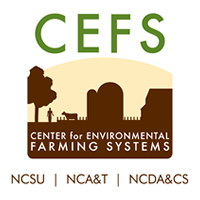To have your name added, contact Amber Polk at amber_polk@ncsu.edu.
Notes from the SUMMIT breakout sessions can now be found on the WIT pages linked below.
- F2F Core Team
- Game Plan
- Advisory Committee
- NC Food NETwork: a North Carolina Food System directory
- SUMMIT
- Working Issues
- Communications
- Community Gardens
- Direct Marketing
- Farm to School
- Local Government & Land Use
- New and Transitioning Farmer Support
- Processing & Food Systems Infrastructure
- Public Health & Food Access Disparities
- Retail & Institutional Markets
- Youth and Social Networking
- Formalizing the Initiative: Foundations & Baselines
- Regional Meetings
- How are we defining LOCAL?
- Regional Meetings Overview & Summary
- Triangle Region SUMMIT breakout session notes
- Mountain Region SUMMIT breakout session
- NorthEast Region SUMMIT breakout session notes
- Southeastern Region SUMMIT breakout session notes
- Triad Region SUMMIT breakout session notes
- Raleigh meeting
- Burgaw meeting
- Asheville
- Charlotte/Concord
- Winston-Salem
- Greenville
Golden Leaf Foundation
Z. Smith Reynolds
Ag Advancement Consortium
W.K. Kellogg Foundation
- CEFS
- Contact Information Form
- NC Choices
- NC Food Network
- Wayne Food Initiative
SUMMIT Working Issue Teams highlights

These are SOME of THE THINGS WE HEARD from WIT breakout group discussions:
1. Foundations & Baselines
• Participants in general think that a Food Policy Council is a good idea.
• Want to make sure its representative and make sure to include youth.
• Concern about who is going to do the work and ensure there is follow-through. A lot of state level commissions and councils are created but need to figure out answers to big questions around staffing & resources.
• How do we make sure the local food policy councils and local efforts feed into the state policy council?
• A lot of terms and issues need to be defined. What is local? What is sustainable? Still some ambiguity and they need to be defined.
• Importance of research and data – make sure we understand how we are doing now, document economic impact and return on investment.
2. Local Governments
• EDUCTION OF POLICY MAKERS — first step; educate local elected officials about the value of benefits of local sustainable food economy particularly on the economic development opportunities; include this in their orientation when they take office.
• State needs a vision for how it will grow that includes consideration of how to build a local, food economy!
• Discussion — hard to discern between a real farmer and a developer – want to be flexible and farmer-friendly but developers often pose as farmers; need to bear this in mind and look at taxation policies.
• Really like the idea of developing 3 policy tool-kits: urban, rural and urban-fringe—tool-kits to include examples of policies, best practices, procedures.
3. Regional & Institutional Markets
• “Feed the Fort” Game Changer — generally positive response but since Fort Bragg is such a large institutional market, it might not be transferable across the state to smaller settings
• This requires that as the Fort Bragg initiative is designed and implemented, we consider how to accommodate and include farmers and businesses of different scales, particularly small and medium scale.
• Major take away: ONE SIZE DOES NOT FIT ALL. Design processes so we accommodate LARGE RETAIL AND SMALL RETAIL AS WELL AS LARGER FARMS AND SMALL FARMS.
4. Communications
• Participants are really energized by the 10% Local Campaign idea; really like that the idea is doable, not overwhelming or insurmountable.
• Group moved right away into a discussion of strategy — how will we do this?
• Focus needs to be on developing a core message that is adapted to different target audiences and markets, including for example inner city vs. suburban vs. rural.
• Focus on seasonal availability of products in messaging.
• NO reason we can’t get started NOW on this campaign; its time begin integrating this into local and regional programs!
5. Public Health & Food Access Disparities
• Considerable discussion about the need to be inclusive as we address the issue of increasing access to local food
o For example, while WIC and Food Stamp programs target low income populations there are a lot of working poor that should not be left out
o And there are sub-groups of the population, such as seniors, that whether they are poor or not, have difficulty accessing local foods.
• Need to education everyone about how to cook with local, seasonal , whole foods. Everyone, whether you’re rich or poor, has largely forgotten how to cook. Need to engage in skill-building activities and increase awareness about the benefits of local food and HOW TO use them.
• Concern – we’re not very well prepared to deal with non-English speaking citizens and we need to build this into our work.
6. Youth & Social Networking
• This group responded very favorably to the concept of creating a NC Youth Corps (the name of a corp was ify, but concept appeals to all).
• Broad concurrence that we’re talking about engaging and mentoring youth and promoting careers throughout the entire food system not just production – including dietician, advertising & marketing, advocates, policy analysts, artisan butchers, chefs, business management and administration, etc…
• Awareness of the complexity and importance of working on dismantling racism within the food system and the challenges and opportunities to build on the good work already being done by existing organizations.
• What about creating a statewide youth food council that could work with the statewide food policy council?
• What is the work you are doing NOW that you can expand to include youth?
7. Farm to School
• Start with educating the professors who train teachers but don’t limit it to educational discipline….include non-traditional classrooms, teachers of anthropology, social studies and other related disciplines.
• Don’t limit it to K-12; got to include highschools – a lot of mentorship opportunities for integrating farm-to-school.
• Connect with and partner with the Teach for America program
• Develop a network within the UNC system to train future food system leaders across all disciplines.
• Strong feeling that there are a lot of existing resources – educational curriculea, state agencies with databases and tool-kits under development but what’s needed is greater coordination and awareness.
8. Community Gardens & Farms
• Education – participants are really excited about how we teach people to garden and, beyond that, how to manage a garden, how to sustain a garden group’s commitment, how to cook with the produce that comes out of the garden, how to prepare it for sale, how to preserve it . . .
• Want a centralized tool kit that can be used by anyone anywhere to teach the “how to’s.” Such a toolkit would include information pertaining to:
- Access funds
- Work with policy makers to acquire land
- Develop private/public partnerships
• Continue to see huge value in mapping and networking existing gardens
• A lot of positive energy around creating “educational hubs” – really do a good assessment of where we have models now that we can learn from and which areas need the development of an educational demo/hub garden.
• Issue of certification was discussed unfavorably—but many intrigued by the idea of branding a community as “local-food friendly” and integrate community gardens into the criteria for this type of branding/certification.
9. Direct Marketing
• Participants recognized an amazing diversity of direct marketing opportunities across the state and the many different ways that direct marketing can occur
• With that, however, came the questions of what is the meaning of direct marketing? Is it, “you grow it AND sell it” or does the definition allow for other arrangements, people and businesses who help aggregate and distribute. No answers but lots of great questions and discussion.
• Serious recognition that direct marketing efforts have to tap into the use of new technology and social networking opportunities (e.g., “twitter your CSA members).
• Information-sharing occurred as well, in which participants got a good overview of the EBT process and regional branding efforts around.
10. Processing & Local Food Systems Infrastructure
• Folks were really energized about how we can try and tackle this complex issue of processing needs and constraints for our state.
• Recognize that we really need to look at the issues of meat distinctly from other food processing & value-added needs.
• We recognize the need to look at disproportionate impacts of regulations on small-scale businesses and producers HOWEVER we don’t want to wait several years to get a study commission up and running; are there ways to move forward now?
• Need to really get a much better understanding of the existing infrastructure available; need a good review & assessment of existing capacity.
• We need to look at REGIONAL scale initiatives – local may be too small-scale when a lot of these needs require significant capital investment
• Infrastructure includes the ECONOMIC CAPACITY whether through risk management or access to capital.
• A lot of enthusiasm for a FOOD CZAR or OMBUDSMAN at the state level to be a point of contact.
• A lot of ways to leverage federal resources at the local level to make process.
11. New & Transitioning Farmers
• Realization that policy impacts everything that new & transitioning farmers face–zoning, planning, taxes –
• Therefore, we really need to understand how regulations impact small and medium scale farmers and make sure decision-makers really understand how even the smallest policy decision can have a big impact on new & transitioning farmers.
• Need to think beyond young farmers to include those who are middle-aged now; how do we keep them engaged – maintain the vitality of farming; keep them on the land now.
